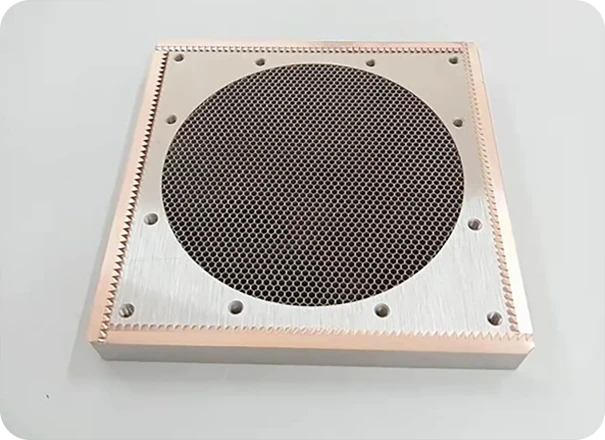
- Afrikaans
- Albanian
- Amharic
- Arabic
- Armenian
- Azerbaijani
- Basque
- Belarusian
- Bengali
- Bosnian
- Bulgarian
- Catalan
- Cebuano
- China
- China (Taiwan)
- Corsican
- Croatian
- Czech
- Danish
- Dutch
- English
- Esperanto
- Estonian
- Finnish
- French
- Frisian
- Galician
- Georgian
- German
- Greek
- Gujarati
- Haitian Creole
- hausa
- hawaiian
- Hebrew
- Hindi
- Miao
- Indonesian
- Italian
- Japanese
- Javanese
- Malay
- Persian
- Portuguese
- Punjabi
- Russian
- Spanish
- Swahili
- Telugu
- Vietnamese

emi-rfi-afgeschermde golfgeleiderluchtventilatieopeningen
Understanding EMI/RFI Shielded Waveguide Air Ventilation Openings
In the rapidly advancing technological landscape, electromagnetic interference (EMI) and radio-frequency interference (RFI) pose significant challenges to the integrity and performance of electronic systems. As devices become smaller, more powerful, and increasingly interconnected, maintaining their performance necessitates innovative solutions for shielding and ventilation. One such solution is the integration of EMI/RFI shielded waveguide air ventilation openings.
The Importance of Shielding
EMI and RFI are disruptive forces that can compromise the functionality of electronic devices. These interferences can arise from various sources, such as nearby electrical equipment, radio transmissions, or even the devices themselves. Shielding is employed to minimize the effects of these interferences. Conventional shielding techniques might include using metallic enclosures or coatings around sensitive components. However, ensuring proper airflow while maintaining effective shielding presents a unique challenge.
Role of Waveguides
Waveguides come into play as specialized structures designed to direct electromagnetic waves. They can be used to manage and control the propagation of signals within a defined path while preventing unwanted emissions. By integrating waveguide principles into air ventilation systems, engineers can create openings that not only allow for optimal airflow but also act as barriers against EMI and RFI.
Designing Shielded Ventilation Openings
Developing effective shielded waveguide air ventilation openings requires a nuanced understanding of both airflow dynamics and electromagnetic principles. The design typically involves
1. Material Selection The choice of materials plays a crucial role. Conductive materials that can effectively attenuate electromagnetic fields, such as copper or aluminum, are often used. These materials can be treated or coated to enhance their performance against specific frequencies.
emi-rfi-afgeschermde golfgeleiderluchtventilatieopeningen

2. Geometric Configuration The shape and size of the ventilation openings influence their effectiveness in providing airflow while maintaining EMI/RFI shielding. Engineers employ specific geometric arrangements that maximize airflow while minimizing openings through which electromagnetic fields can penetrate.
3. Frequency Considerations Different applications might require shielding against various frequencies. As such, the design of the waveguide openings needs to take into account the frequency range of potential interferences to ensure that they are effectively blocked.
4. Integration with Existing Systems Shielded waveguide air ventilation openings must be designed for compatibility with existing cooling mechanisms, such as fans or heat exchangers. It is crucial to ensure that while optimizing for EMI/RFI performance, the overall thermal management of the electronic system is not compromised.
Challenges and Solutions
One of the primary challenges in implementing EMI/RFI shielded waveguide air ventilation openings is balancing airflow and shielding effectiveness. Too many or improperly sized openings can lead to inadequate shielding, while overly restrictive designs can impede necessary cooling. Engineers often utilize simulation software to model airflow and electromagnetic behavior. These simulations allow for optimization prior to physical prototyping, saving time and resources.
Moreover, regular testing and validation in real-world scenarios are essential. Compliance with international standards regarding EMI/RFI shielding ensures that products meet required performance benchmarks, thereby enhancing reliability and customer satisfaction.
Conclusion
EMI/RFI shielded waveguide air ventilation openings represent a sophisticated solution to the contemporary challenges of electronic device design. By skillfully integrating shielding with effective thermal management, engineers can ensure that devices operate efficiently in a world that is increasingly reliant on seamless electronic communication. As technology continues to evolve, innovative approaches like these will remain crucial in safeguarding performance and reliability across a myriad of applications.
Products categories
-
Why Vented Aluminum Honeycomb Is Leading the Way in Shielding and Ventilation SolutionsNewsJul.18,2025
-
Why Stainless Steel Honeycomb Panel is the Ultimate Choice for High-Tech Shielding and ProtectionNewsJul.18,2025
-
Why Honeycomb Strips Are Revolutionizing High-Speed Sealing SolutionsNewsJul.18,2025
-
Shielded Glass Innovation Powers the Future of Electromagnetic ProtectionNewsJul.18,2025
-
Precision Starts Here: Revolutionizing Airflow Control with Honeycomb Wind Tunnel SolutionsNewsJul.18,2025
-
Elevate Industrial Performance with Precision-Engineered Steel Honeycomb Core SolutionsNewsJul.18,2025
-
Vented Aluminum Honeycomb: A Smart Shield for Airflow and EMI ControlNewsJul.11,2025















